Why Are The Leaves On My Sago Palm Turning Yellow?
Sago palm leaves turning yellow or showing spots is a sign of an underlying cause such as overwatering or underwatering, nutritional deficiency, transplant shock, or too much/too little sun.
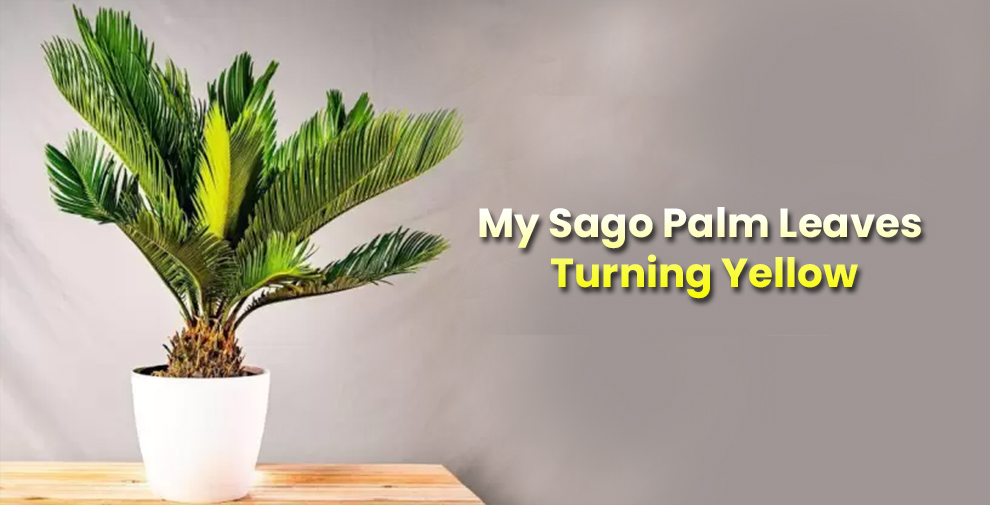
It can be disheartening to look out into your garden or indoor space and see your once-vibrant Sago Palm starting to turn yellow. These unique plants are often prized for their attractive appearance and easy care, making them a popular choice for many gardeners and plant enthusiasts.
If you are reading this, you must be looking for answers to ‘why is my sago palm turning yellow.’ Know that when your Sago Palm starts to show signs of yellowing, it can be a sign of underlying issues that require attention.
One of the most common causes of yellowing is overwatering or under-watering, which can cause stress to the plant and affect its ability to absorb nutrients.
Another common cause is nutrient deficiencies, such as a lack of nitrogen, potassium, or magnesium. Pests, diseases, and environmental factors such as excessive sunlight or low humidity can also contribute to yellowing.
Identifying the root cause of the issue is key to restoring the health and vibrancy of your plant.
In this guide, we will explore the most common reasons why Sago Palms turn yellow and provide practical solutions to help you restore your plant to its former glory.
Why Do Sago Palms Turn Yellow?
These slow-growing Sago palms can turn yellow due to a variety of reasons, including overwatering, under-watering, nutrient deficiencies, pests, disease, aging, or environmental stress.
Let us look into some of these reasons in detail:
1. Natural aging
Sometimes the yellowing is natural and a part of their normal lifecycle. As the sago palm matures, the oldest leaves near the base of the plant will naturally turn yellow and die off.
You can’t do much about this. All you got to do is prune off any yellowing leaves as they appear, to help the plant focus its energy on new growth.
2. Nutritional deficiency
Deficiencies that can affect your sago palm include:
A. Nitrogen
Nutrient deficiencies, such as a lack of nitrogen, can reduce chlorophyll, and the plant may start to turn yellow. To remedy a nitrogen deficiency in sago palms, you can apply a balanced, slow-release fertilizer that contains a high percentage of nitrogen.
Improve the nitrogen levels in the soil by incorporating organic matter, such as compost or well-rotted manure.
B. Potassium
Potassium is a macronutrient that plays a critical role in many plant functions, including regulating water movement, promoting root growth, and improving stress tolerance.
When a sago palm is deficient in potassium, it may exhibit yellowing or browning of the leaf margins, along with stunted growth and reduced fruit production.
Apply a potassium-rich fertilizer or improve the potassium levels in the soil by incorporating potash, which is a common source of potassium, into the soil around the plant.
C. Magnesium
Without sufficient magnesium, the plant cannot produce enough chlorophyll, leading to the yellowing of the leaves.
In addition to yellowing, it may also exhibit interveinal chlorosis, where the veins of the leaves remain green while the tissue between them turns yellow.
Incorporate magnesium-rich organic matter, such as compost or Epsom salt, into the soil around the plant or use magnesium-rich fertilizer.
3. Incorrect watering schedule
If your plant is young and its nutrient needs are being met, you must be confused why are the leaves on my Sago Palm turning yellow. Well, overwatering can lead to root rot and other fungal diseases as well that can cause the plant to turn yellow and eventually die.
Underwatering, on the other hand, can cause the leaves to wilt and turn yellow as the plant tries to conserve water.
Avoid overwatering the plant. Ensure that the soil is well-draining and allow it to dry out slightly between watering.
4. Sago palm turning yellow in summer – insufficient or too much sunlight?
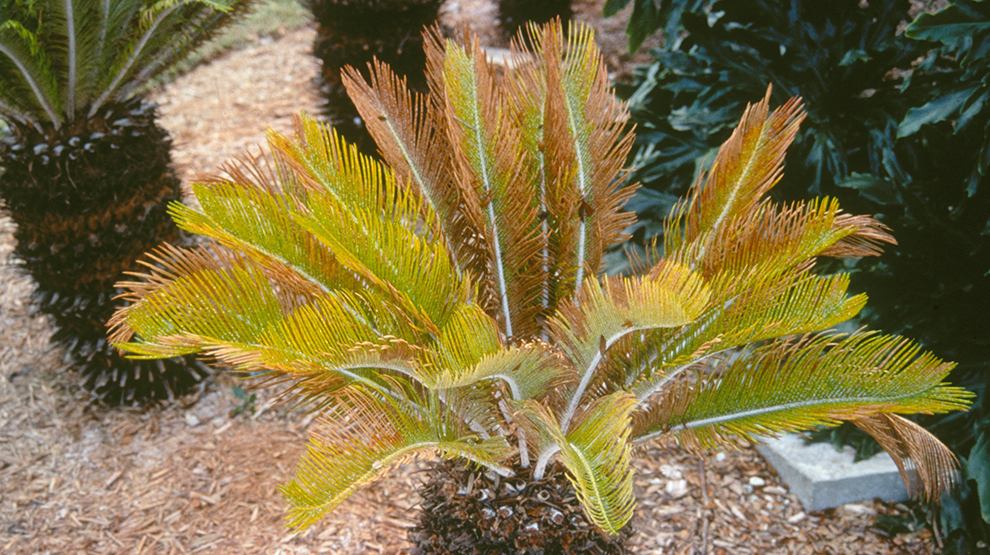
Sago palms prefer bright, indirect light, and they can suffer from sunburn if they receive too much direct sunlight. On the other hand, if the plant is not getting enough light, it may start to yellow and lose its vibrant green color.
Consider the plant’s placement and the amount of light it receives. In case of too much light, move the plant to a location that receives bright, indirect light or provides some shade to protect it from direct sunlight.
If your plant is shaded or receives very little light, move it to a location with more light, such as a south-facing window or a bright spot outdoors.
5. Diseases & Pest attack
Insect infestations or diseases, such as scale or mealybugs, can also weaken the plant and cause it to turn yellow.
Regularly inspect the plant for pests and diseases, and take appropriate measures to prevent or treat them.
6. Overuse of fertilizers resulting in burns
Fertilizers contain salts that, when applied in excess, can accumulate in the soil and cause toxicity issues for the plant. This can ultimately lead to the yellowing of the leaves.
Avoid applying too much fertilizer, and be sure to water the plant thoroughly after fertilizing to help flush excess salts out of the soil. If the plant is in a pot, consider repotting it with fresh soil to help dilute the excess salts.
7. Sago palm turning yellow after freeze is also a common sight

Sago palms are tropical plants that prefer warm temperatures. Exposure to extreme temperatures, such as cold snaps or hot, dry conditions, can cause yellowing.
Protect them from extreme temperatures and ensure that they are not exposed to drafts or hot, dry air.
8. Transplant shock

During transplant shock, the plant’s roots can become damaged or disturbed, which can impact the plant’s ability to absorb water and nutrients. This can cause yellowing of the leaves, wilting, stunted growth, and leaf drop.
To prevent or minimize transplant shock in a sago palm, choose an appropriate time to transplant the plant. In general, it’s best to transplant sago palms in the spring or fall, when temperatures are moderate and there is less stress on the plant.
Before transplanting, make sure the new location has suitable soil and light conditions for the plant. When transplanting, be careful to avoid damaging the roots and to plant the palm at the same depth as it was in its previous location.
Water the plant thoroughly after transplanting, and consider using a root stimulator or transplant fertilizer to promote healthy growth.
9. Low humidity
Sago palms prefer a warm, humid environment and can suffer if the air around them is too dry. When the air is dry, the plant can lose moisture through its leaves faster than it can absorb it through its roots. This can cause the leaves to dry out and turn yellow or brown.
Increase the humidity around the plant by either using a humidifier in the room where the sago palm is located. This can help to add moisture to the air and create a more humid environment.
Alternatively, you can mist the leaves of the plant with a spray bottle to add moisture directly to the leaves. You can also place a tray of water near the plant.
We have provided a comprehensive understanding of the issue for those wondering why do Sago Palms turn yellow. So, providing proper care and attention to the sago plant’s needs will help prevent yellowing and ensure the long-term health and beauty of sago plants.
| DID YOU KNOW – Sago Palms are not true palms!!!
While sago palm varieties share some similarities with true palms, such as their palm-like leaves and tropical appearance, they have some distinctive features that set them apart. For example, sago palms produce cones rather than flowers, and they have a unique growth pattern in which new leaves emerge from the center of the plant in a tightly coiled manner. Additionally, sago palms are toxic to pets and humans if ingested, whereas true palms are not typically toxic. |
Should I Cut Yellow Leaves Off The Sago Palm?
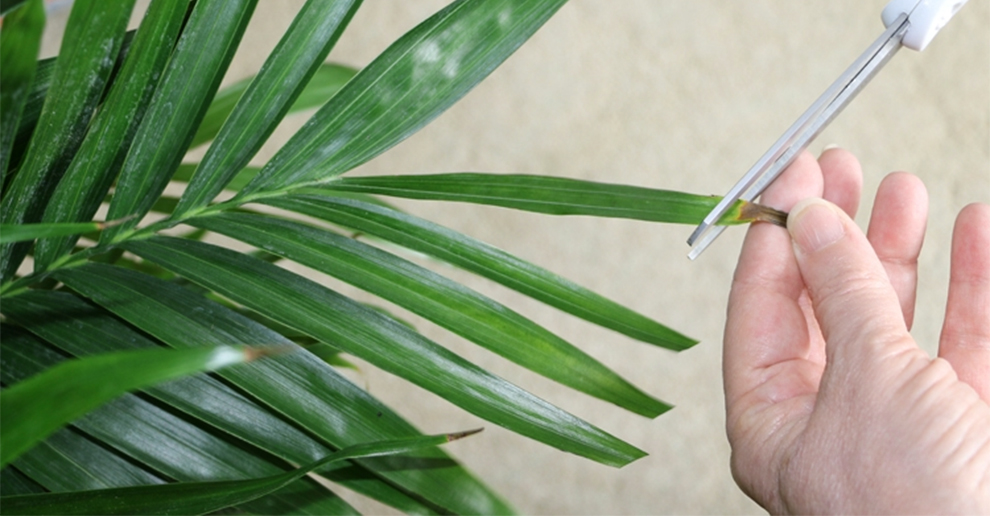
Yes, it’s a good idea to cut yellow leaves off a sago palm as soon as possible. But keep in mind that yellow leaves are just a symptom of an underlying problem. Cutting them will not cure the underlying cause.
In addition, cutting off yellow leaves can also help to improve the overall appearance of the plant. Yellow leaves can be unsightly and detract from the plant’s beauty. By removing them, you can help the plant to look healthier and more attractive.
When cutting off yellow leaves from a sago palm, be sure to use clean, sharp pruning shears. Cut the leaf as close to the base of the plant as possible without damaging any other healthy leaves. If you notice that multiple leaves are turning yellow, it may be a sign of a more significant problem, and you should investigate further to determine the underlying cause.
Can Yellow Sago Palm Leaves Turn Green Again?
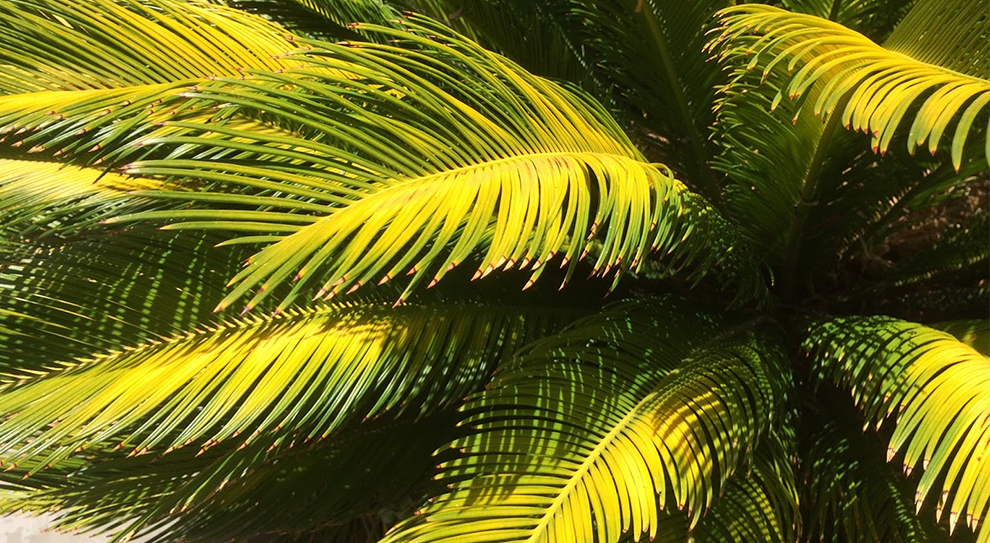
Yes, sago palms can regrow green leaves if the plant damage is minimal and the underlying cause is addressed promptly.
It’s important to note that if the yellowing is due to a pest or disease issue, it may take some time for the plant to recover fully.
However, with prompt and appropriate treatment, the plant can regain its health and start producing new green leaves.
It’s also worth noting that yellow leaves may not turn completely green again, especially if they are severely damaged. However, new growth from the plant should be healthy and green, indicating that the plant is recovering.
How Do You Fix A Yellow Sago Palm?
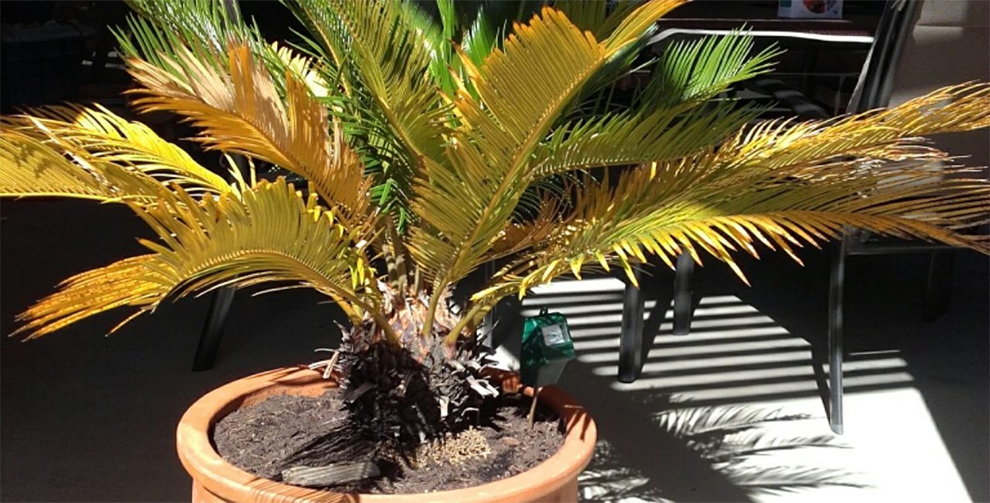
If you are wondering why is my Sago palm tree turning yellow, know that a yellow sago palm may indicate a few possible problems. Here are some steps you can take to fix a yellow sago palm:
- Check for overwatering: Sago palms prefer well-drained soil, and overwatering can lead to yellowing. Make sure the soil is not too wet, and avoid watering too frequently.
- Check for underwatering: On the other hand, under-watering can also cause yellowing. Make sure the soil is moist and water the sago palm when the top inch of the soil feels dry.
- Check for nutrient deficiencies: Sago palms need certain nutrients to thrive, including nitrogen, potassium, and magnesium. A lack of these nutrients can cause yellowing. You can add a slow-release fertilizer or a palm-specific fertilizer to the soil.
- Check for pests or diseases: Sago palms can be affected by pests such as spider mites, scale insects, and mealybugs, as well as diseases such as root rot. Treat any pest or disease issues promptly to prevent further damage.
- Ensure proper sunlight: Sago palms need bright but indirect light. Make sure the plant is not receiving too much direct sunlight, which can cause burning and yellowing of the leaves.
By addressing these possible issues, you can help your yellow sago palm to recover and regain its healthy green color.
